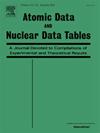Theoretical Study on the Infrared and Ultraviolet Spectroscopy of PO+
IF 2.7
3区 物理与天体物理
Q2 PHYSICS, ATOMIC, MOLECULAR & CHEMICAL
引用次数: 0
Abstract
In this study, the potential energy function, dipole moment function, and transition dipole moment function of the PO+ are computed employing high-precision multi-reference configuration interaction methods. By solving the one-dimensional Schrödinger equation for the nuclei, vibrational and rotational energy levels of eight bound states are obtained, subsequently enabling the calculation of the partition function for the PO+ molecule. Combining the partition function with the dipole moment function and transition dipole moment function, spectral lines for the PO+ molecule in both the infrared and ultraviolet ranges are computed. The spectral lines in the infrared range primarily originate from vibrational-rotational transitions associated with the state, while the spectral lines in the ultraviolet range mainly arise from transitions involving the . At 296 K, the most intense spectral lines in the infrared range are generated by the 0–0 vibrational band(), while the most intense spectral lines in the ultraviolet range are produced by the 2–0 vibrational band(). At elevated temperatures, the overall intensity of spectral lines decreases as more energy levels are excited, and the central positions of spectral peaks undergo shifts. This study extensively computed the spectral line data for the PO+ molecule, providing crucial data support for astronomical observations.
PO+红外和紫外光谱的理论研究
本文采用高精度多参考位态相互作用方法计算了PO+的势能函数、偶极矩函数和跃迁偶极矩函数。通过求解原子核的一维Schrödinger方程,得到了PO+分子的八个束缚态的振动能级和旋转能级,从而可以计算PO+分子的配分函数。结合配分函数与偶极矩函数和跃迁偶极矩函数,计算了PO+分子在红外和紫外范围内的谱线。红外范围内的谱线主要来自与X1Σ+状态相关的振动旋转跃迁,而紫外范围内的谱线主要来自X1Σ+↔C1Π的跃迁。在296 K时,红外范围内最强烈的谱线是由0 - 0振动带(v ' =0,v″=0)产生的,而紫外范围内最强烈的谱线是由2 - 0振动带(v ' =2,v″=0)产生的。在高温下,随着激发能级的增加,光谱线的总强度降低,光谱峰的中心位置发生偏移。本研究广泛计算了PO+分子的谱线数据,为天文观测提供了重要的数据支持。
本文章由计算机程序翻译,如有差异,请以英文原文为准。
求助全文
约1分钟内获得全文
求助全文
来源期刊

Atomic Data and Nuclear Data Tables
物理-物理:核物理
CiteScore
4.50
自引率
11.10%
发文量
27
审稿时长
47 days
期刊介绍:
Atomic Data and Nuclear Data Tables presents compilations of experimental and theoretical information in atomic physics, nuclear physics, and closely related fields. The journal is devoted to the publication of tables and graphs of general usefulness to researchers in both basic and applied areas. Extensive ... click here for full Aims & Scope
Atomic Data and Nuclear Data Tables presents compilations of experimental and theoretical information in atomic physics, nuclear physics, and closely related fields. The journal is devoted to the publication of tables and graphs of general usefulness to researchers in both basic and applied areas. Extensive and comprehensive compilations of experimental and theoretical results are featured.
 求助内容:
求助内容: 应助结果提醒方式:
应助结果提醒方式:


